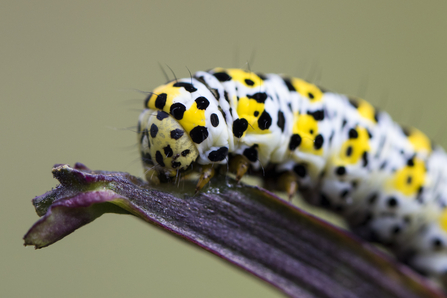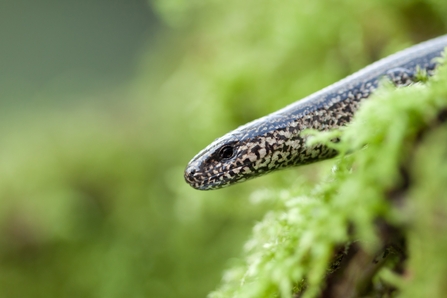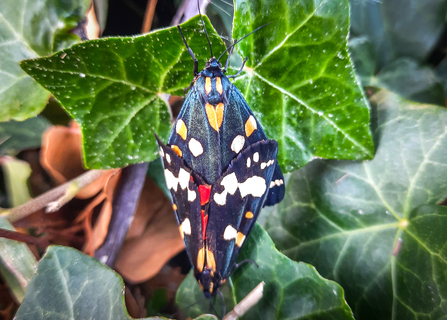
Mullein moth caterpillar ©Chris Lawrence
Just one 1 teaspoon of thiamethoxam can kill 1.25 BILLION bees. Jon Hawkins - Surrey Hills Photography

Mullein moth caterpillar ©Chris Lawrence
The mullein moth is an unusual species, in that it is better known as its larva than an adult: while its final form is small and brown, the caterpillars are an attractive pale blue with striking black and yellow spots. In June they can be found in their dozens demolishing the leaves of mullein plants from which they get their name. Look out for them at grasslands like our Yoesden nature reserve near High Wycombe.
Find out how to attract butterflies and moths to your garden

A ruby-tailed wasp at BBOWT's Warburg Nature Reserve. Picture: Rachael Maytum
Another tiny wild highlight that's really worth looking out for this month is the miniscule ruby-tailed wasp. We've already seen a few this year at our Warburg reserve near Henley - see our reserve officer Chris Trew's amazing photo above. Although less than a centimetre long, these are one of the UK's most beautiful insects with glittering emerald heads, azure thoraxes and ruby-coloured abdomens.

A child holding a young froglet. Picture: Ross Hoddinott/ 2020Vision
One of our favourite wild highlights of summer is always froglets and toadlets: having spent the past two months as tadpoles, this is the time when they start to make their first furtive forays onto dry land! Look out for them popping out of the ponds at our CS Lewis reserve in Oxford, Kintbury newt ponds in Berkshire and the Upper Ray Meadows near Bicester.


Bird's-foot trefoil at BBOWT's Woolley Firs nature reserve. Picture: Pete Hughes
With its yolk-coloured petals and crimson buds, it's not hard to see why bird's-foot-trefoil has earned its breakfast-based nickname. Another of its evocative names is 'granny's toenails', which gives an instant impression of the claw-like seed pod! Look out for it at our Yoesden reserve near High Wycombe, which is a hive of activity at this time of year.

A slow worm (Anguis fragilis). Picture: Jamie Hall
The slow worm is neither a worm nor a snake, but a legless lizard - its identity is given away by its abilities to shed its tail and blink with its eyelids. Slow worms can be found in heathland and tussocky grassland where they hunt invertebrates and sunbathe. We found this beautiful specimen at our Snelsmore Common reserve near Newbury a couple of weeks ago:

A slow worm at Snelsmore Common. Picture: Rich Tilley
A glow worm at BBOWT's Dancersend nature reserve near Aylesbury. Picture: Mick Jones
Like the slow worm, the glow worm is not a worm at all - in fact, it's a beetle with a remarkable twist! On warm nights at this time of year, females will climb up plant stems and signal for males. We are very lucky to have a population at our Grangelands reserve near Princes Risborough in Buckinghamshire.

A Daubenton's bat in flight. Picture: Dale Sutton/2020Vision
June is a great month to look for bats. Did you know we have 16 species of these flying mammals in the UK? If you go outside at dusk on any warm evening you can have a good chance of spotting tiny pipistrelles, a brown long-eared or a Daubenton's flitting around and catching insects. Why not join our bat walk at Windsor Great Park on 7 June where we'll use a detector to discover more about bat and their world.

Nightjar by David Tipling
We are also hosting four nocturnal expeditions this month and next to spot the amazing nightjar: these magical migratory birds spend their winters Africa, but return to several BBOWT nature reserves in Berkshire to nest each summer. Males display to females by flying around, wing-clapping and making their distinctive 'churring' call. Some of our nightjar walks are already fully-booked, so reserve a place now if you'd like to join us:

European badger (Meles meles) family and cubs feed in long grass near their woodland sett. Picture: Bertie Gregory/2020VISION
Having been born deep underground in the spring, this year's badger cubs are now starting to emerge. Mostly they will do this at night, but you might catch them at dawn or dusk if you are lucky. Did you know - a single badger can eat several hundred earthworms in one night!

A mating pair of scarlet tiger moths. Picture: Pete Hughes
Among the most beautiful and dramatic UK moths are the scarlet tigers: at rest, their green velvet upper wings camouflage them perfectly against leaves, but when they take flight they flash their brilliant scarlet hind wings to dazzle and confuse predators. If you love insects, join our butterfly and moth walk at the Nature Discovery Centre on Saturday, 10 June, or come along to our butterfly and dragonfly hunt at Snelsmore Common the next day.
Sign up below to receive the latest news from BBOWT, tips about how you can help wildlife, plus information on how you can get involved.